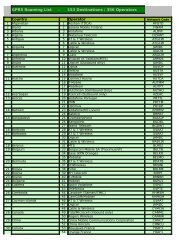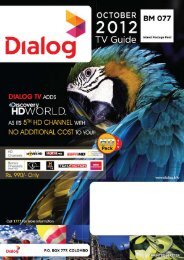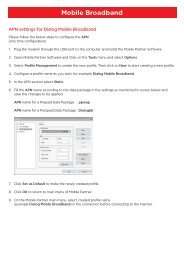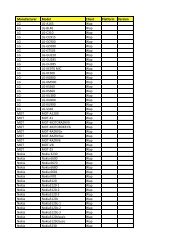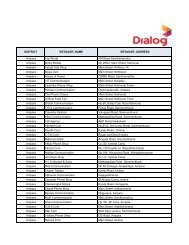Annual Report 2012 - Dialog
Annual Report 2012 - Dialog
Annual Report 2012 - Dialog
You also want an ePaper? Increase the reach of your titles
YUMPU automatically turns print PDFs into web optimized ePapers that Google loves.
(iii) Net investment hedge<br />
<strong>Annual</strong> <strong>Report</strong> <strong>2012</strong> l <strong>Dialog</strong> Axiata PLC l 67<br />
Hedges of net investments in foreign operations are accounted for similarly to cash flow hedges.<br />
Any gain or loss on the hedging instrument relating to the effective portion of the hedge is recognised in statement of<br />
comprehensive income within ‘other comprehensive income’. The gain or loss relating to the ineffective portion is recognised<br />
immediately in the statement of comprehensive income within ‘other gains/(losses) – net’. Gains and losses accumulated in<br />
equity are included in the statement of comprehensive income when the foreign operation is partially disposed of or sold.<br />
2.9 Inventories<br />
Inventories are stated at the lower of cost and net realisable value. Cost is determined on a weighted average basis and<br />
comprises all expenses incurred in bringing the inventories to their present location and condition. Net realisable value is<br />
the estimated selling price in the ordinary course of business, less applicable variable selling expenses. In arriving at the net<br />
realisable value, due allowance is made for all obsolete and slow moving items.<br />
2.10 Trade and other receivables<br />
Trade receivables are amounts due from customers for merchandise sold or services performed in the ordinary course of<br />
business. If collection is expected in one year or less (or in the normal operating cycle of the business if longer), they are<br />
classified as current assets. If not, they are presented as non-current assets.<br />
Trade receivables are recognised initially at fair value and subsequently measured at amortised cost using the effective<br />
interest method, less accumulated impairment losses.<br />
2.11 Cash and cash equivalents<br />
For the purpose of the statements of cash flows, cash and cash equivalents includes cash in hand, deposits held at call with<br />
banks, other short-term highly liquid investments with original maturities of three month or less and bank overdrafts. Bank<br />
overdrafts are shown within borrowings in current liabilities in the statement of financial position.<br />
2.12 Stated capital<br />
(a) Classification<br />
Ordinary shares with discretionary dividends are classified as equity. Other shares are classified as equity or liability according<br />
to the economic substance of the particular instrument. Distribution to holders of a financial instrument classified as an equity<br />
instrument is charged directly to equity.<br />
(b) Share issue expenses<br />
Incremental costs directly attributable to the issuance of new shares or options are shown in equity as a deduction, net of tax<br />
from the proceeds.<br />
(c) Dividend to shareholders of the Company<br />
Dividend distribution to the Company’s shareholders is recognised as a liability in the Company’s and the Group’s financial<br />
statements in the period in which the dividends are approved by the Company’s shareholders.<br />
2.13 Trade and other payables<br />
Trade and other payables are obligations to pay for goods or services that have been acquired in the ordinary course of<br />
business from suppliers. Accounts payable are classified as current liabilities if payment is due within one (1) year or less (or<br />
in the normal operating cycle of the business if longer). If not, they are presented as non-current liabilities.



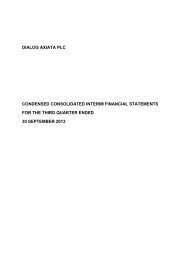
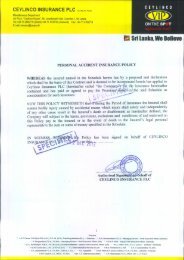
![nrypq;Nfh ,d;#ud;;]; nfhk;gdp ypkplw - Dialog](https://img.yumpu.com/15429071/1/190x245/nrypqnfh-dud-nfhkgdp-ypkplw-dialog.jpg?quality=85)
